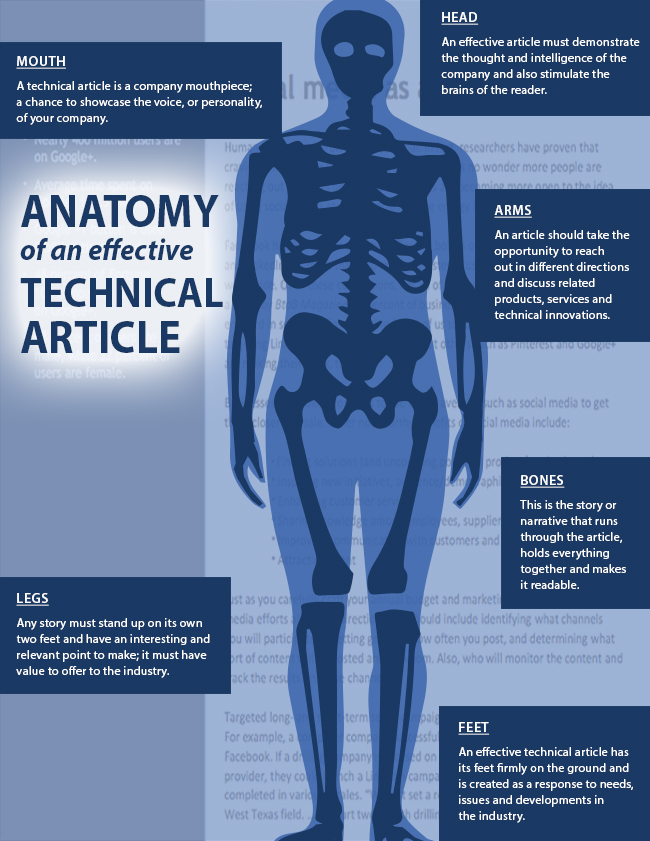As a public relations tool, a technical article is a cost-effective way for your company to communicate and engage, at length and in-depth, with large segments of your target market. A technical article can reach thousands of potential readers all over the world, and will often have bonus distribution at a variety of relevant trade shows. Therefore, it is vitally important that enough time and consideration is given to creating an article that really makes the most of your company’s moment in the spotlight.
With word counts of approximately 2,000 words, constructing a technical article can be both time-consuming and potentially challenging for clients who are more used to working with heavy equipment than words. Here, we can help break down the anatomy of an effective technical article.
Mouth: A technical article is a company mouthpiece; a chance to showcase the voice, or personality, of your company. An article written with very little flair for language will suggest that your company lacks creative communication skills, and consequently the ability to engage effectively with a client in all the complex negotiations inherent in mutual project work. Conversely, an article that is big on overblown sales language, (derogatively referred to as “fluff”) but sketchy on the technical details, will be viewed as nothing more than a disguised form of advertising, and will not be taken seriously as a useful technical resource. It is usually best to adopt an objective, non-boastful tone, throughout an article that supports well-articulated points with solid technical descriptions.
Legs: We emphasize to our clients the importance of giving “legs” to any story that is pitched to the media. By legs, we mean that any story for external communication (news release, technical article, press conference, etc.) must stand up on its own two feet and have an interesting and relevant point to make; it must have significant value to offer to the industry as a whole. It is not enough to write a technical article about “business-as-usual” technology that has not evolved in decades. The media is only interested in technical articles that provide something new for their readers. Before beginning a technical article, we encourage clients to answer a series of questions such as: “What is unique about this technology?”; “How is this technology being used in new and innovative ways?”; and “What industry needs have you identified that no one else was capable of addressing?” We call this addressing the “so what?” factor.
Head: The article must demonstrate the thought and intelligence of the company behind it, and also work to stimulate the brains of the reader. An effective article should give food for thought. It should leave the reader thinking about the implications of this particular technology for his or her business. It should generate fresh ways of thinking, and stimulate new ways of doing things throughout the industry. This really is the ultimate aim with all technical articles.
Arms: An article with arms reaches out in different directions to discuss, or at least hint at, related products, services and technical innovations, even if those topics are not strictly within the scope of the article. By referencing and signposting potential external areas of interest to the reader, you have used the opportunity to connect with readers with all manner of differing business needs. It is always useful to establish connections and spark ideas in the readers’ mind relating to other industry areas or potential applications. After all, a technical article aims to disseminate as much information as possible, and may lead to business opportunities not previously considered.
Bones: The bones of the article are the story or narrative that holds everything together, and makes it readable. With so many articles, news stories, blogs, videos and websites vying for readers’ attention, it is vital for your article to be clear, compelling, focused and interesting from the first paragraph. Setting the context for delivering the technical content is key to not only retaining the reader’s interest long enough for them to want to finish the article, but also for them to be able to remember the information relayed, your company’s name and brand names of products long after they have finished reading. Transforming sometimes “dry” technical information into a reader-friendly format that makes the key messages clear and compelling, in order to command the widest readership possible for the article, can be a challenge, but it is worth the effort.
Feet: An effective technical article has its feet firmly on the ground and is created as a response to real needs, issues and developments in today’s modern industry. The technology discussed must speak directly to today’s industry decision makers, and demonstrate that the company has acute awareness of the challenges the readers are looking to solve on a day-to-day basis. We encourage clients to cite their most recent project work to support technical examples, and, wherever possible, to discuss current and future technical developments and their reasons behind pursuing them.
By bearing in mind these various elements of anatomy that must come together to form the body of an effective technical article, your company will be well-equipped to present a positive company image as a thought-leader, and produce a resource of information that is sufficiently valued by readers and industry publications alike.

Need help with your next technical article or other communications efforts? We can help. Call us today at 281-448-3435.
